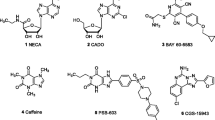Abstract
2-(2-Benzofuranyl)-2-imidazoline (2-BFI) has recently been characterised as a selective ligand for the I2-type of imidazoline-receptor binding site(s) (I2-RBS). The present studies determined the relative levels of specific [3H]2-BFI binding to membrane homogenates of brain and kidney from rat, guinea pig and rabbit and identified the pharmacological characteristics of [3H]2-BFI binding sites in rabbit kidney membranes. Rabbit kidney membranes had the highest relative density of specific [3H]2-BFI binding of all tissues studied (2000 fmol/mg protein). Rabbit brain and guinea pig kidney had moderate levels of specific [3H]2-BFI binding (350–500 fmol/mg protein), while rat kidney and guinea pig and rat brain displayed much lower densities of binding (40–65 fmol/mg protein).
Studies of [3H]2-BFI binding kinetics in rabbit kidney homogenates revealed binding to two distinct sites with K d values of 0.10 ± 0.01 nmol/l and 1.00 ± 0.36 nmol/l respectively. Equilibrium saturation studies were also consistent with the presence of two binding sites – [3H]2-BFI (0.01–20 nmol/l) bound to sites with affinities of 0.10 ± 0.01 nmol/l and 0.92 ± 0.13 nmol/l and binding densities of 470 ± 80 and 840 ± 60 fmol/mg protein (n=3), representing 36 and 64% respectively. Drug inhibition studies revealed that l-adrenaline; α1-adrenoceptor drugs (prazosin, l-phenylephrine) and α2-adrenoceptor drugs (rauwolscine, methoxyidazoxan, 2-(2,4-(O-methoxyphenyl)-piperazin-1-yl)-ethyl-4,4-dimethyl-1,3-(2H,4H)-isoquinolindione (ARC-239) had extremely low affinities for [3H]2-BFI binding sites (IC50 ≥ 10 μmol/l). Putative I1-RBS compounds, p-aminoclonidine, moxonidine, imidazole-4-acetic acid and cimetidine, inhibited [3H]2-BFI binding to rabbit renal membranes with low to very low affinities (K i values 3 to ≥100 μmol/l), suggesting [3H]2-BFI does not label I1-RBS in rabbit kidney membranes. I2-RBS compounds – 2-(4,5-dihydroimidaz-2-yl)-quinoline (BU224), 2-(4,5-dihydroimidaz-2-yl)-quinoxaline (BU239), idazoxan and cirazoline – potently inhibited [3H]2-BFI binding (K i values 0.37–1.6 nmol/l), confirming the labelling of I2-RBS. Inhibition of [3H]2-BFI binding by certain compounds was consistent with their interaction with two binding site populations – for example (drug, K i values) guanabenz, 0.65 nmol/l and 0.17 μmol/l; naphazoline, 0.94 nmol/l and 2.8 μmol/l; amiloride, 76 nmol/l and 26 μmol/l rilmenidine, 150 nmol/l and 50 μmol/l; and clonidine, 230 nmol/l and 70 μmol/l. The high affinity of amiloride for a high proportion (85%) of the binding is consistent with the presence of the I2A-subtype of I-RBS in rabbit kidney.
These results demonstrate that [3H]2-BFI is a highly selective and high affinity radioligand for I2-RBS which should be useful for the further characterisation of these sites in mammalian tissues.
Similar content being viewed by others
Author information
Authors and Affiliations
Additional information
Received: 4 June 1996 / Accepted: 28 August 1996
Rights and permissions
About this article
Cite this article
Hosseini, A., King, P., Louis, W. et al. [3H]2-(2-Benzofuranyl)-2-imidazoline, a highly selective radioligand for I2-imidazoline receptor binding sites Studies in rabbit kidney membranes. Naunyn-Schmiedeberg's Arch Pharmacol 355, 131–138 (1996). https://doi.org/10.1007/PL00004911
Issue Date:
DOI: https://doi.org/10.1007/PL00004911




